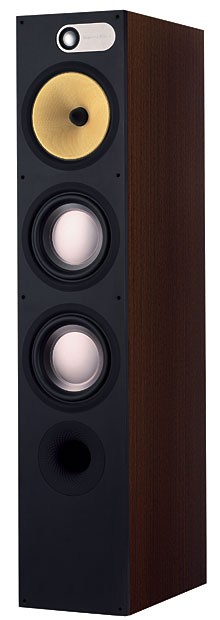B&W 683 Surround Speaker System
 While its product range includes some of the most expensive loudspeakers on the market, B&W has always worked hard to bring as much of its advanced technology as possible to more affordable designs. And the new 600 Series goes further in that regard than any of the company's earlier lines that carried that designation.
While its product range includes some of the most expensive loudspeakers on the market, B&W has always worked hard to bring as much of its advanced technology as possible to more affordable designs. And the new 600 Series goes further in that regard than any of the company's earlier lines that carried that designation.
The price of the B&W 683 system isn't exactly pocket change, but it's about the most expensive combination of 600 series models you can put together (short of using floor-standers in all channels and/or choosing the somewhat heftier ASW610XP subwoofer). Even so, $3,450 for a complete 5.1-channel speaker package, including a single subwoofer but excluding any stands you might need, is a bargain in today's market for the sound quality this system offers. As is the case with so many British (and other) speakers today, the 600series is manufactured in China in a factory owned and managed by B&W. But its design and engineering work remains firmly rooted in the U.K.
In For a Penny
The system we chose to review consists of a pair of the floor-standing 683s for the left and right channels, the HTM61 center channel, a pair of bookshelf-sized 685s for surrounds (there's also a dedicated bipole/dipole surround in the 600 lineup that we did not test) and the ASW610 subwoofer (the ASW610XP was not available when we requested our samples).
All of the full-range 600 series models share a similar cosmetic theme. They are available in one of three good quality vinyl veneers. The front baffles are painted black and have a slightly tactile feel. A Bowers and Wilkins logo, on a brushed aluminum plaque, wraps around the tweeters. The look is tasteful and a bit more upscale than is typical at these prices.
The floor-standing 683 stands on a slightly wider base that gives the narrow cabinet better stability, but is the only slightly cheap-looking element of the system design. If I owned a pair of 683s I'd be tempted to take one of these bases (they're packed separate from the cabinet) to a good cabinetmaker and have duplicates made at double or triple the thickness, finished in black to match the front baffle (or to taste).
On the back of each speaker apart from the sub, are two pair of good, five-way input quality terminals. They're normally strapped together but may be separated for either bi-amping or bi-wiring.
The 685 also has a rear bracket for wall mounting. But I recommend something more secure if you live in earthquake country. The slot in the bracket is designed to slip over a sturdy screw, but it isn't very deep; in a strong shock the speaker could easily jump out of it.
The ports, located in the front of the 683 and 685 but on the back of the HTM61, employ B&W's "FlowPort." This dimpled and tapered port outlet design is said to minimize turbulence of the air flowing through it, minimizing the port noises that this can cause. Removable foam plugs are also included with each model to fine-tune the bass response for different rooms and setups. You can leave them off or use them to partially or completely fill the ports.
B&W is one of the few speaker manufacturers with the resources to design and build its own unique drivers. It claims to be the first speaker company to use stiffened, woven Kevlar for its speaker cones, and the familiar yellow fabric is visible in all of the speakers here apart from the subwoofer.
The real story here is the 6-inch midrange driver in the 683s and HTM61. Yes, it has that familiar Kevlar cone, but there's a lot more to the story than that. Readers familiar with B&W's product line will instantly recognize this as the same FST driver (Fixed Suspension Transducer) B&W first used nearly a decade ago in the flagship 800 series and has continued to refine over the intervening years. This driver has gradually been incorporated into lower cost models, and these new 600 series speakers are the least expensive yet to employ it.

The flexible surround used in most speakers may appear innocuous, but in fact it is one of the more troublesome aspects of speaker design, radiating sound on its own at some frequencies—and often out of phase with the radiation from the cone itself. But in the FST, the outer edge of the cone is, essentially, surround-free, supported instead by a thin foam ring (hopefully this material will be more durable over time than the foams which were once used for traditional surrounds). The small area and absorptive properties of this vestigial surround, combined with the relatively small movement of the cone at midrange frequencies, is said to greatly reduce this random and destructive radiation.
In addition to the cone and surround, the FST midrange employs a copper sheath on the center pole piece for lower distortion. To minimize reflections from the back of the cone, the rear basket (which connects the rim of the speaker to the magnet structure) is also designed to be as open as possible (see photo). The driver uses neodymium magnets for the same reason. Neodymium magnets are more powerful than the cheaper ceramic magnets used in most speakers. They can be smaller and still do the same job.





























































